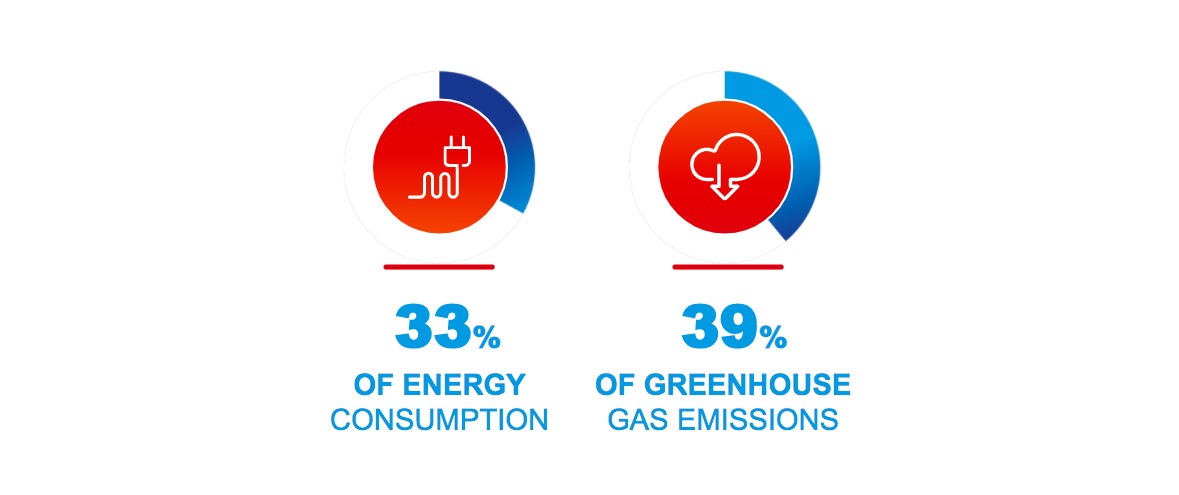
The idea of “decarbonization” has gained significant traction in political discussions and international environmental gatherings in recent years. However, it has not yet received the necessary focus in the field of architecture to meaningfully transform our design and construction practices for the future. Currently, buildings account for 33% of global energy consumption and 39% of greenhouse gas emissions. This statistic underscores the critical role architects must play in our efforts to halt or reverse climate change. By using carbon as a universally accepted measure, we can effectively track the greenhouse gas emissions associated with buildings. Consequently, one of the most vital strategies for achieving our climate goals is the decarbonization of architecture.

Decarbonization involves reducing both operational carbon and embodied carbon. Operational carbon refers to emissions produced during the building’s use phase, while embodied carbon encompasses emissions generated throughout the entire life cycle of a building, including material extraction, transportation, installation, usage, and disposal. This comprehensive life cycle contributes to 11% of global greenhouse gas emissions and 28% of total emissions within the building sector. Therefore, addressing both aspects is essential.
Several initiatives, such as the Net Zero Carbon Buildings Commitment launched at the Global Climate Action Summit in 2018, advocate for significantly reducing operational carbon. These efforts aim for annual carbon dioxide emissions to reach zero or even negative levels.
Furthermore, other programs like the U.S.’s Carbon Leadership Forum highlight the need to tackle embodied carbon. They stress the urgency of this issue, particularly in light of projections indicating that the world’s building floor space will double by 2060. Clearly, the decarbonization of architecture must be prioritized if we want to ensure a sustainable future.
1. Decarbonization Architecture: A Three-Level Approach
Different carbon reduction strategies vary in effectiveness, and different phases of a building project require distinct methods. To address this, the World Resources Institute (WRI) suggests a hierarchy of strategies for decarbonization, divided into three main levels. According to the WRI, the best approach to reducing operational emissions follows this order:
- Prioritize energy efficiency before adopting renewable energy,
- Utilize on-site renewable energy before turning to off-site options,
- Invest in carbon offsets only after exhausting other options for renewable energy.
For embodied emissions, a similar approach applies: reduce carbon output before considering carbon offsets. Carbon offsetting ranks low on the priority list because it should only be used when a 100% renewable energy supply isn’t achievable. Thus, we can approach building decarbonization through three main levels:
1. Reduce operational carbon in existing buildings by focusing on energy efficiency.
2. Select renewable energy sources to meet remaining low energy demands, ideally sourced on-site or nearby if necessary.
3. Minimize embodied carbon in new buildings throughout their entire life cycle.
It’s important to note that these levels are not a strictly linear process; instead, they highlight different methods architects can use to cut carbon emissions based on the stage or requirements of each building project. Achieving all three goals is essential to align with the targets outlined in the Paris Climate Agreement, and understanding these levels helps architects and building owners navigate their decarbonization efforts effectively.
2. Integrating Operational and Embodied Carbon in Design
To achieve comprehensive decarbonization in architecture, it’s vital to reduce both operational and embodied carbon. In existing buildings, where materials are already in place, the top priority should be reaching net-zero operational carbon. In contrast, architects working on new constructions should evaluate both operational and embodied carbon simultaneously. If they consider only one type, they might overlook crucial aspects of a structure’s overall environmental impact. For instance, some materials may result in low operational carbon but high embodied carbon, while others may have opposite effects.
A building with minimal insulation and single-glazed windows may have lower embodied carbon but higher operational carbon compared to a well-insulated counterpart. Additionally, while renewable energy systems can substantially lower operational carbon, architects must recognize that the production of these systems also contributes to carbon emissions. It is essential, therefore, for architects to assess both carbon outputs during the material selection process to optimize energy efficiency and minimize the overall carbon footprint.
3. Focus on the Early Project Phase
To effectively reduce carbon emissions, architects should prioritize decarbonization from the very beginning of a project. Implementing low-carbon design strategies, particularly those addressing embodied carbon, is most effective and cost-efficient in the early stages. The “Embodied Carbon Review” by One Click LCA explains that decisions made during these initial phases significantly influence embodied carbon emissions. For instance, selecting a site with deep foundation requirements can drastically increase a project’s embodied carbon, and such critical choices are difficult to change later on. As projects progress, even changes that are possible typically come with higher costs. Therefore, architects must analyze opportunities for embodied carbon reduction early in the design process.
4. Emphasizing Lightweight Materials
One effective strategy for architects is the use of lightweight materials. A study by Saint-Gobain analyzed two internal wall systems used in Brazil, revealing that the lighter Placo drywall system brought numerous environmental benefits. Replacing conventional cement-plastered brick walls with this drywall led to a 63% reduction in global warming potential, a 49% decline in primary energy use, an 80% decrease in wall weight, and a 36% reduction in freshwater consumption. Similarly, a lighter external wall system, Façade F4, exhibited half the CO2 emissions of traditional massive facades. These findings not only highlight the effectiveness of lightweight materials but also provide architects with practical options for sustainable design.
5. Utilizing Biosourced Materials
In addition to lightweight options, architects should consider biosourced materials like wood, hemp wool, and wood fibers. These materials can effectively store carbon over their life spans, helping to reduce atmospheric carbon dioxide levels before they are disposed of. However, architects must recognize that according to the new EN15804-A2 Life Cycle Assessment standard, the carbon stored during plant growth (biogenic carbon) must be accounted for separately from embodied carbon due to significant differences. For instance, a biosourced material’s embodied carbon could be higher than traditional materials if sourced from a considerable distance, and biogenic carbon is categorized as zero carbon emissions over its life cycle.
6. Recognizing Interior Elements as Carbon Contributors
A common oversight in design is neglecting to include interior elements, such as fittings and technical systems, in calculations of embodied carbon. These components, which often have shorter lifespans and may be replaced multiple times, can significantly contribute to the overall carbon footprint of a building. Accurately assessing embodied carbon requires consideration of all elements, including interiors and adjustments made during renovations. Architects must therefore adopt a holistic approach, factoring in not just the primary structural materials but also secondary elements such as fixtures, finishes, and systems that contribute to the overall embodied carbon of a building project.
7. Decarbonize Architecture by Reusing or Recycling Existing Materials
Reusing materials significantly reduces the environmental impact of extracting and manufacturing new ones. Architects should prioritize purchasing products made with a high percentage of recycled materials, which helps lower embodied carbon. For instance, in glazing, using glass made from cullet—recycled, decarbonated waste glass—can reduce energy consumption by 3% for every 10% of cullet incorporated. Moreover, using one ton of cullet cuts CO2 emissions by 300 kg. Therefore, architects aiming to decarbonize architecture should strongly consider using cullet and other recycled materials.
8. Utilize Life Cycle Assessments and Verified Environmental Product Declaration
Architects can assess a building’s carbon output through Life Cycle Assessments (LCAs) that meet international standards and through third-party verified Environmental Product Declarations (EPDs). These sources provide credible data on the embodied carbon of construction materials. LCAs analyze a product’s environmental impact from cradle to grave, while EPDs are verified documents that relay clear and comparable information about a product’s life cycle impact. By using both tools, architects can effectively evaluate their designs’ carbon footprints. International standards, like European EN 15804, regulate these assessments, making them vital for architects focused on reducing carbon emissions in construction.
9. Integrate Buildings into the Circular Economy
An important aspect of life cycle assessment is how we handle products at the end of their life. Transitioning from a ‘take, make, waste’ model to a circular economy is essential for creating a sustainable building industry. Buildings that follow circular economy principles consume fewer resources over their lifespan by being adaptable and long-lasting. Incorporating materials with a higher percentage of recycled content will lower their carbon footprint, while reused products further reduce embodied carbon. These strategies exemplify how the circular economy is crucial for decarbonizing architecture. With the building sector accounting for about half of all extracted materials and one-third of waste in Europe, implementing reuse and recycling can significantly contribute to combating global warming.
10. Support Global Initiatives
While each of these strategies is vital, decarbonizing architecture requires a collective global effort for effective change. Firms can enhance advocacy and awareness by supporting local and global initiatives, such as the Net Zero Carbon Buildings Commitment, the Global Alliance for Buildings and Construction, and the Carbon Leadership Forum, among others.
Conclusion
Decarbonizing architecture is not just an opportunity; it is an urgent necessity if we are to combat climate change effectively. By implementing strategic approaches that address both operational and embodied carbon, architects and builders can lead the way toward a more sustainable future. Utilizing lightweight and bio-sourced materials, prioritizing early project-phase decisions, and integrating circular economy principles are critical steps in this transformation.
Additionally, collaborating with global initiatives strengthens the collective impact of these efforts. The path to decarbonization requires innovation, commitment, and a unified direction, but the potential benefits—environmental restoration and a sustainable built environment—are worth every effort. It is time for architecture to embrace its pivotal role in achieving climate goals and ensuring a resilient planet for future generations.


